Jenni Meredith discusses the hidden disability Blue Badge extension
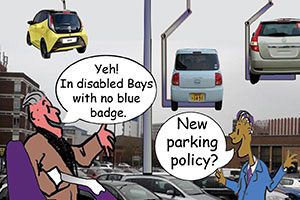
UCan2 Jenni Meredith warns that although the legislation is changing, there’s more to be done if everyone who needs a Blue Badge is to receive one – and find somewhere to park! Some of you reading this, will have taken part in last year’s consultation about extending the Blue Badge scheme to those with hidden disabilities. But most of us know from public dialogues in other fields, such as planning or health care changes, that the consultation process is merely an exercise. It gives civil servants experience in producing forms, creating charts of the results and providing statistics for the press department, but almost always the opinions of the public are ignored, unless of course those opinions coincide with what the consulting authority wanted to hear. Too cynical a view? Well, perhaps. In any case, this consultation was slightly different. The overwhelming response was positive. We’ve only just begun… However, in widening the eligibility for a blue badge the Department for Transport will also need to plan for more on-street parking spaces and presumably to issue new guidelines to increase the mandatory percentage of disabled parking bays in private car parks, such as those at supermarkets, hospitals, galleries and museums, etc. Plus, there is likely to be more abuse of the system if non-disabled drivers think they can get away more easily with parking in a disabled bay, claiming a hidden disability — ‘Oops! Forgot the blue badge’, or ‘…It’s in the post’. In May at a Gloucestershire car park, not one but two cars parked in disabled bays when the car park was otherwise almost empty. Why do some people behave so arrogantly and with such disregard for others? In the same week in Liverpool two women came to blows over who should be parked in a disabled parking bay – and neither of those two had a disability. It’s not just the general public who abuse the scheme either. One Government Minister, in his efforts to be re-elected, was caught blocking a disabled parking bay with his campaign posters. That was in Australia, so at least it’s not only in England that we suffer from ignorant MPs. Is technology the answer? One solution, pictured in the cartoon, could kill two birds with one piece of technology. You wouldn’t be too keen to find your car hanging in the air if you unlawfully parked in a disabled bay, would you? Technologies exist to stack cars in a sort of rotating pile, so that the driver merely needs to drive into one spot and the car is then moved along a vertical conveyor belt, something like the London Eye, to one of the upper positions. But these are mainly used at ports, shipping cars to other destinations. It seems feasible in that situation where the cars are all empty. Combine this with self-parking cars and you might have a solution for disability parking. A blue badge holder could park really close to the entrance of, say a supermarket, then command the car to go and park anywhere in a stack. When the owner exits the store, all they would have to do would be to summon the car with their key fob and it would arrive at the entrance within minutes, ready to be manually driven again. I suppose we need to wait for the teething problems to be ironed out on this technology, and for the price to drop too. But I like the idea of a car behaving rather like a faithful work-horse. Let’s not pass the buck In Wales, people with certain hidden disabilities have been eligible for a blue badge under an extension of the scheme since 2014.The Welsh Government ruled that people with cognitive impairments including autism could successfully apply for a blue badge. However it’s not all good news there either. In reality it has proved difficult for people in certain parts of Wales to convince their local authorities that they are, in fact eligible under the extended criteria. The problem, as usual, lies in the interpretation of words. The Government says local authorities have the responsibility for deciding who is and who isn’t eligible and the local authorities say they are following Government guidelines. It’s a familiar scene of buck-passing and confusion. One authority has an autism team to assist applicants, whilst others refuse applications if there is not ‘sufficient supportive medical evidence’. Maybe when the English and Irish extended scheme finally comes into effect, it will be just such a postcode lottery— hopefully not. Jenni who writes health-related poetry – at wordsart.co.uk • Cartoon by Tony Meredith
Why autism needn’t be a barrier to finding a job
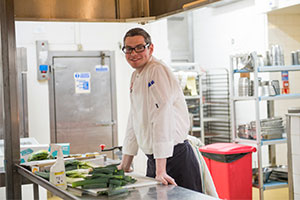
Autism and learning difficulties can often make recruitment difficult – for both the candidate and the employer. Can local forums help overcome such barriers to finding a job, and enable companies to make their workforce more diverse? Here Sue Webster, Employer Engagement Officer at SkillsHouse Bradford and Caron Munro, Development and Programme Manager at Lighthouse Futures Trust, discuss with UCan2 the Employers’ Forum in Yorkshire which has been set up to find more people a suitable job. When it comes to getting young people with autism or learning difficulties into work, what are the most common barriers to recruitment? The whole online recruitment and interview process is one of the main barriers to the young person as they may not have the written or verbal communication skills to sell themselves effectively. Therefore, employers who can offer a ‘working interview’ such as a supported internship, or work experience placements etc would give the young person the opportunity to demonstrate their hidden talents to the employer who will find it easier to recognise how they could benefit the company – and in many cases be the better candidate for the role. Employers may also feel uncertain about employing individuals with a learning difficulty and be concerned that they would not know how to give them the best experience at work, however with disability and/or Autism Awareness training this would not be an issue. A key to success lies in having fully trained job coaches on site who learn the role and support the interns throughout their placement. Employers who have hosted supported internships and who spoke at the Bradford Employer’s Forum Launch spoke very passionately about the effect on employer engagement for the whole company, focusing on diversity and inclusion which reflects their customer base. How did the idea for the Employer’s Forum come about: who is behind the launch? In November 2017, the government announced £9.7m for local authorities to increase the number of supported internships and other pathways to employment for young people with SEND, by establishing local supported internship forums and increasing the pool of expert job coaches available to support young people with SEND on work placements. Bradford City Council put the project out for tender and Lighthouse Futures Trust (LHFT), a Leeds-based charity, were the successful bidders. LHFT have been delivering supported internships since 2016 when they embarked on their first pilot with Yorkshire Water. The Leeds Employers Forum now includes organisations such as Johnson and Johnson, Sodexo, Anchor Hanover, KPMG, Burberry, John Lewis Partnership and Marriott Hotels. The members follow the journey of the interns and support the charity into getting them into paid work when internships finish. Tell us about what happens at the Employer’s Forum… The Employers’ Forum Launch was held in June this year at City Hall in Bradford. We had over 30 employers attending. Many of those expressed an interest in finding out more and arrangements were made to meet with them individually. The first Forum Meeting is kindly being hosted by Mark Cowgill of Exa Networks in Bradford in September. Employers who have an interest in offering support to young people with hidden talents will be attending. The support could range from hosting an internship, work experience placement, workplace visits, mentoring, providing industry-relevant courses, influencing changes to recruitment processes etc. How will young people with autism or learning difficulties benefit from the Forum? The young people furthest from employment will benefit by having direct access to major employers in the region. In Leeds the forum works because we do not always have to go through the usual recruitment process. Candidates are supported by a job coach who understands they way they like to learn. They are likely to feel more visible and supported when allowed to demonstrate what they can do. Going into a workplace is likely to increase self-respect, self-esteem and a sense of belonging. This means candidates are less likely to suffer from depression or a feeling of isolation by being at home all the time. Are you still inviting more employers to join the Forum? Yes – if any employers are interested in attending or finding out more about the Forum in Leeds or Bradford they can contact caron@lighthousefuturestrust.org.uk or sue.webster@bradford.gov.uk Lighthouse Futures Trust Case Study: Ross Here Jayne Uren, Human Resources Manager at Leeds Marriott Hotel, discusses her experience working with Ross Hall, who is on the autistic spectrum… I would like to let you know how things are after several months of working with one of your students, Ross Hall. Back in 2017 our Executive Chef and I visited Keepers Coffee & Kitchen in Cookridge, this was after we initially met and discussed a potential vacancy we had in our kitchen. We met Ross, who was at the time running the catering side of your establishment. It didn’t take long for us to realise how passionate he was in what he did and also what he wanted to do. We saw his potential and wanted to help him with his next career journey. Ross was successful in his application for the role of Culinary Apprentice and he has been in his role now for 12 months. He is part of our MCAA Programme and has enrolled on his NVQ to complete the necessary training required for the Apprentice Chef role. I cannot express how he has changed people’s mindsets and had brought a laughter and happiness to the team and within the hotel. We can see how your students have so much to offer if employers gave them an opportunity or a chance. They add value to your business and should be given every opportunity to succeed and grow as young people into adults. The Leeds Marriott would love to continue to work with you and enrich our education with supporting young people in the workplace and hopefully we may be in a position to offer further employment. If any companies have any doubts about building a partnership with you then I would say, this is their loss. We would also like to thank you for
Gitcombe retreat offers accessible holidays in Devon
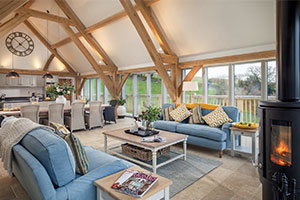
Gitcombe’s exclusive collection of nine 4* and 5* luxury self-catering properties now includes a ‘Retreat’ ideal for those with mobility needs to take accessible holidays. To mark its recent expansion, owners father and son, Rodney and Peter O’Brien, have partnered with national holiday letting agency cottages.com. The partnership will bring guests from across the UK to their luxurious holiday properties in South Devon, including its newly built Retreat for large gatherings. The Retreat is a stunning newly built property designed to emulate a restored barn, complementing the quintessentially British feel to the Georgian properties elsewhere on the estate. This latest addition recognises the need for a modern and accessible large property suitable for large parties and fully supportive of those with mobility issues. Prime location Gitcombe’s nine luxurious holiday properties are clustered in a private, south Devon valley, between Dartmouth and Totnes, close to an ‘Area of Outstanding Natural Beauty’. The “Gitcombe Retreat”, which accommodates eight adults and one infant, has been designed by award-winning architect, Roderick James and is a stylish and modern property in a commanding position on the Gitcombe Estate. Building work began in November 2017 taking ten months to transform the property into a stylish home full of charm and period features. The property has been built with a traditional oak frame design, which is fully glazed two sides and a private hot tub with spectacular far-reaching views across the majestic rolling countryside. Peter said: “Our vision which began in 2013, was to establish ourselves as a luxurious destination for those looking to explore South Devon. It’s been a real labour of love but we’re thrilled with the expansion and looking forward to tapping into the marketing expertise of cottages.com to encourage even more visitors from across the UK.” “We were keen to keep our focus on high level luxury, with sleek kitchens, elegant soft furnishings, luxury bathrooms, log fires, private patios, English pared down styling with a contemporary Scandi touch. We’re confident that holidaymakers will continue to appreciate the superior level of detail found in all of our properties.” The property benefits from modern luxuries with under floor heating throughout the property, designer bathrooms by award-winning Sapphire Spaces and a heat recovery system for the comfort of the guests. Disabled friendly One of the most important aspects for the owners when designing the property was to ensure that it catered for customers with mobility difficulties. Assessed by Visit England using the National Accessible Scheme, the property achieved ratings of Mobility One (older and less agile guests) and Mobility Two (part time wheelchair users). Access is directly through the main front door into the living area and the ground floor bedroom. There are flush thresholds throughout and the bathroom allows the wheel chair to access the shower and toilet. There is an inset hand rail leading to the shower and grab rails through out and a wheelchair on site for guests to use. The Retreat has four large bedrooms, accommodating eight guests and additional infants. With a stunning Fired Earth Limestone floor leading into a light, extremely spacious and impressive contemporary oak frame open plan living area, it’s a breath-taking space for special occasions and gatherings, with unspoilt views offering privacy and seclusion at the same time. Guests have exclusive use of the shared heated indoor and outdoor swimming pools, sauna and steam rooms, children’s indoor play area, outdoor hot tub and full size tennis court. Stunning surroundings Gitcombe near Totnes is close to a beautiful coastline, stunning beaches and the chic waterside towns of Dartmouth and Salcombe. Totnes has earned a reputation for eccentricity beyond the usual cream tea and antiques shop fare that characterises this part of the world. With its vintage clothing shops, independent shops, boutiques art galleries and interiors shops, over the years it’s attracted a boho crowd from London. Back in 2007 Time magazine tipped Totnes as the capital of New-Age chic. The Gitcombe Estate There are nine different self-catering properties at Gitcombe – including the very recent completion of Gitcombe Retreat which provides accessible holidays: Accessible holidays with real luxury Mark Warnes, Vice President of Property Services at cottages.com said: “This luxurious collection of properties, including the recent addition Gitcombe Retreat, offers an incredible line-up of stunning options for those looking to explore a pristine part of South Devon. The passion and dedication from father and son Rodney and Peter is evident in every property detail, making it a truly beautiful place to stay.” To book accessible holidays at Gitcombe Retreat (UKC3973), which sleeps eight in four bedrooms and costs from £1,224 for 3 nights, see cottages.com
Line-up revealed for mental health arts festival

The full line-up for the All in the Mind Festival 2019 has been officially revealed. More than 30 exciting theatre, dance, visual art and musical acts from around the UK will descend on Basingstoke for one day only, to shine a light on mental health. Three stages will cover Eastrop Parkon Saturday 14 September – the Dance Space, the Spoken Word & Music Stage, and the Theatre Tent. Other acts and activities will also take place around the park. The free festival was started by Leigh Johnstone of Fluid Motion Theatre Company four years ago, to encourage performers and artists to explore mental health themes and to break the stigma that still surrounds many aspects of mental health and personal wellbeing. Leigh, from Bursledon, said: “I am delighted to announce the full line up for the festival – it is going to the most vibrant and exciting event we have put on. All of the acts are extremely talented and will provide fun, engaging and thought-provoking performances.” Performances will explore topics such as anxiety, abusive relationships, self-harm and the challenges of caring for people who experience mental health issues. Laura Greenway, from Basingstoke, will explore the physical and emotional effects of depression in an interactive performance. The audience will take up the role of ‘the illness’, constantly fuelling those afflicted with negative thoughts and intrusions. Laura said: “All in the Mind is such an important event as it encourages the public to be able to talk about issues surrounding mental illness, which in turn helps to dramatically reduce the stigma can surround mental health problems. Being an artist, whose work solely focuses on my own experiences of mental illness, I know how incredibly important the aim of this festival is, and I am delighted to have been a part of this unique festival since its first year. Talking about mental health problems can literally save lives, and so I am thrilled to be a part of this amazing and life-changing event.” Lots to do for children at mental health festival There will be many activities and performances suitable for younger audiences as well. Collar & Cuffs Co, who are based in Bedfordshire, will put on a musical sensory and play session for children up to the age of seven, that will explore the themes in William Shakespeare’s The Tempest. Julie Collar, Creative Director, said: “This is our second time at the festival: we are so passionate about what it stands for, and about having the opportunity of creating space for families to encounter topics relating to children’s emotional development. You’re never too young or have such complex needs that you can’t explore what mental health and wellbeing are, or to have a little toolkit of safe and healthy strategies you can use with your grown-ups or carers to feel soothed when feelings become overwhelming.” The All in the Mind Festival first started in 2016 with 79 visitors and last year’s event saw more than 1,300 people attend. The 2019 event promises to be the biggest and best yet and has received nearly £30,000 of funding from the Art’s Council. The festival is a culmination of a year-long programme of work by Fluid Motion, which includes working in schools and colleges to help young people build skills, increase confidence and self-esteem as well as working with adults with dementia using drama to help increase interaction, improve physical and mental wellbeing and reduce social isolation. The funding from the Arts Council is the largest amount of funding Fluid Motion has ever received. Fluid Motion has also recently become a partner of the Without Walls Creative Development Network; a network that supports arts organisations across England with peer learning, knowledge and skill sharing to organise and deliver new festivals. All in the Mind takes place on Saturday 14 September and people wanting to attend must register for their free tickets at aitmfestival.com
PM launches disability policy overhaul

Prime Minister Theresa May has revealed plans to enhance the lives of those living with a disability in the UK, announcing the launch of disability policy Equalities Hub in Parliament. With around a fifth of the working-age population living with a disability, the Prime Minister also announced a new cross-government disability team which will sit alongside the Government Equalities Office and Race Disparity Unit in a new Equalities Hub. This team will work closely with disabled people, disabled people’s organisations and charities to develop a new approach to disability, with their views and experiences at the forefront of any new policy. Further measures will be set out later this year. The new package of measures ordered by the Prime Minister includes: • Higher accessibility standards for new housing • an overhaul of statutory sick pay • greater workplace support • a spotlight on companies’ delivery of services for the disabled • New research on disabled people and government policy Outgoing PM Mrs May said: “My determination to identify and tackle injustices, wherever they exist in society, remains as strong as ever. “So I am proud to announce new measures to break down barriers faced by disabled people, whether in employment, housing or elsewhere. “We all have a crucial role – businesses, government and civil society – in working together to ensure that disabled people get the support they need, and go as far as their talents can take them.” Disability focus widely welcomed Mark Hodgkinson, Chief Executive at disability equality charity Scope, said: “Continued action from government to tackle the barriers Britain’s 14 million disabled people face is welcome. “Making workplaces more flexible, improving market regulation and government coordination are positive steps in the right direction. “We know that half of disabled people feel excluded from society, and are too often shut out of work. Life also costs more if you are disabled, and Scope research shows that these costs add up to on average £583 a month. “We have long called for a concerted effort from government to improve the lives of disabled people in this country. It is therefore positive to see recognition from government that a joined-up approach is needed and necessary.” Responding to the announcement of a consultation on the accessibility of new homes, Sheron Carter, CEO of Habinteg housing association said: “Currently only 7% of homes in England have even the most basic access features so we really need all new housing to offer good levels of accessibility and adaptability if we’re to get anywhere near meeting the needs of our whole population. Too many disabled and older people are making do in homes that are just not suitable for them. “We’re not talking about grand designs for every home. The ‘accessible and adaptable’ standard that will be consulted on is purely an ordinary home with some thoughtful design features that make it easier to get around and more adaptable to the changing needs of households over time. “Our recent accessible homes forecast revealed that less than half of all planning authorities have set requirements for new homes to meet higher accessibility standards. Setting a national policy would not only create a level playing field and more certainty for developers, it would help shift the focus of planning at an authority level to ensure that a sufficient number of new homes are suitable for wheelchair users to live in.” Habinteg’s Insight Report revealed that just 1% of homes set to be built by 2030 outside London are set to be suitable for wheelchair users.
How accessible is the public transport system?
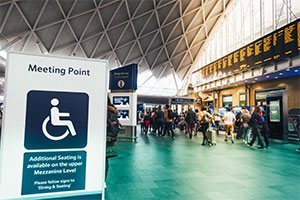
In England during 2017/2018, the Department of Transport found that a population of 9.8 million held older and disabled concessionary travel passes. With that in mind, is there enough being done to make the nation’s means of public transport accessible for disabled people and the elderly? With assistance from stairlift manufacturer Acorn Stairlifts, we’ve investigated this issue… Across the UK a lot of the population choose public transport to get from A to B. The Department for Transport’s Transport Statistics, Great Britain 2018: Moving Britain Ahead, reported that 4.85 billion local bus passengers were completed through the UK during 2017/2018 and National Rail completed 1.71 billion passenger journeys. During the same period, 270 million passengers used light rail and tram systems, which is a record since comparable records were documented. Issues being highlighted regarding accessible public transport UK-based poet and artist, Jamie Hale and voiced his disappointment towards the UK’s transport system and feels that it doesn’t cater enough for disabled passengers in an opinion piece for The Guardian, going as far as to state that London alone “has one of the best public transport systems in the world, yet only about a quarter of underground stations are fully accessible for me”. Being also an activist with groups like Disabled People Against Cuts, and Not Dead Yet UK, Mr Hale was keen to point out some positive feedback, regarding London’s public transport system. He accredited buses in the city for having wheelchair-accessibility and the pavements are passable, while a system entitled Turn Up & Go is designed to allow passengers who are disabled to travel spontaneously. However, Mr Hale does go on to express strongly that London’s rail network has a reliance on staff-assisted travel for many of disabled passengers. Using a real-life situation, Mr Hale had said that this means he must wait for a staff member to set up a ramp and then assist him with boarding the train – many times of which he ends up travelling within the vestibule of the transportation system. He added: “Even when the train has a wheelchair space, I’m rarely put in it. If I want to get off, I have to hope the staff remember me. They often don’t, leaving me either shouting at passengers to find platform staff or relying on friends. Otherwise, I have to eat into my care hours and bring a carer with me who can find staff when I’m inevitably forgotten. Of my last six journeys, I was only met correctly on two — the rest of the time, the ramp didn’t arrive, or it was sent to the wrong part of the train.” Mr Hale, had continued to point out potential solutions, if were to be implemented would make both London’s and the wider UK’s transport system more accessible by including: 1. Ensuring all trains have proper spaces for wheelchair users. 2. Improving how those requiring assistance to alight from public transport can alert staff members on a platform when the necessary help hasn’t arrived. 3. Increasing the number of dedicated assistance staff members available for those using public transport. 4. Introducing automated ramps which extend from trains to platform level. 5. Making it free for carers and assistants to use public transport. It’s not just Mr Hale, who feels aggravated by these issues too. Within its Independent. Confident. Connected report, disability equality charity Scope found that 40 per cent of disabled people often experience difficulties or issues when travelling via train across the UK. One in four also stated that negative attitudes from fellow passengers has led to them restricting their use of public transport. The head of policy and public affairs at Scope, James Taylor stated: “From airports to buses, we’ve heard too many horror stories of disabled people let down by poor infrastructure, bad service, or being treated as an afterthought. This urgently needs to change.” “A genuinely inclusive transport network would allow disabled people to be part of their community, work, and see family and friends. Progress towards fair and inclusive transport has been slow, and disabled people want to see change happening a lot faster.” The Legal rights for accessibility on transport The 2010 Equality act was introduced to cover the legality surrounding provision of accessible transport and completely replacing all prior equality legislation, such as Disability Discrimination Act. The premise of the act is to ensure that transport implements adjustments to provide a service for disabled people which is of the same standard to that of non-disabled people. Assistance measures should be put in place by those effected, to ensure that accessibility is met for disabled customers. The regulations mean that providers must do the following: 1. Not charge a disabled people extra or refuse to ravel to someone based on their ability 2. Refuse a disabled person from travel under genuine safety reasons 3. Must guarantee accommodation for disabled people where prior notice is given and provide extra assistance if no notice is made. 4. Provide basic assistance in the terminal, when loading/unloading luggage or boarding/alighting from the transport 5. Display information in accessible formats 6. Provide training for all staff members in disability awareness and handling associated equipment 7. Provide compensation for lost or damaged equipment 8. Must allow registered assistance dogs to travel on transport including buses and coaches Other methods of transport have slightly varying rules, for travel by sea and waterways: 1. Assistance dogs are permitted but must follow national rules 2. A temporary requirement should be provided if equipment is lost or damaged 3. Standards of assistance should be filed by large establishments The Equality Act also sets requirements for guidelines regarding public transport vehicles, such as trains, buses, coaches and taxis and there are to be outlined by the government. The standard allowance for travel is based on a ‘reference wheelchair, which measurements are a length of 1200mm, including extra-long footplates with a total width of 700mm. The sitting height from ground to top of head shouldn’t exceed 1350mm and the
Making accessible holidays easier to find
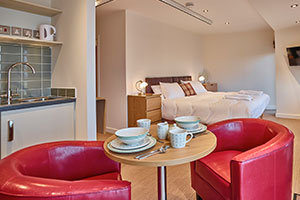
Moira Henderson has dedicated herself to making accessible holidays easier to find in Fife, for as many people as possible. And she’s doing such a great job, Prince Charles recently presented her with an MBE. Editor Victoria Galligan asked Moira about her crusade and her cottages The Rings, which can sleep up to 16 people. Q&A with accessible holidays champion Moira Henderson When did you first become involved in the hospitality industry? About 28 years ago we brought a second-hand residential caravan onto our farm, so I guess that was my start in hospitality. I became increasingly involved when we started to think about accessible tourism, although I didn’t know that was what it was called until a chance meeting with Chris McCoy of Visit Scotland. Chris helped me to network with those affected by disability and their feedback helped shape my “wish list”. I was then invited by Scottish Enterprise to join the group Planning to Succeed, designed to guide those involved in agriculture to diversify into tourism. This group was very educational and supportive. What is your role on the board of Fife’s Tourism Associations? I am Chair of the North Fife Local Tourist Association and I also have recently taken the Chair of The Fife Tourism Partnership. In these roles I try to encourage businesses to network and learn from each other. We keep an eye on changes in legislation – such as the attempt to introduce a Tourism Tax! We also put forward the views of those we represent. We look at the needs of businesses, such as staff requirements, and liaise with schools and colleges, encouraging them to consider the long-term needs of local business in their planning. Our aim is to keep the vibrant industry we have in Fife moving in the right direction. Marketing is of course vital and we are constantly reviewing how we are performing. Why did you decide to build The Rings – and why was accessibility at the heart of the project? My first thought was to build a two-bedroom cottage! We were affected by disability in our family and latterly I nursed my Mum who had a severe stroke which required her to be hoisted. How do you go on holiday when you have specialist beds, hoist and shower chair all to transport? And that is assuming the doors are wide enough to get in when you arrive! I realised there were very few properties available. My friend suggested we build something a little bigger than the two-bed I was considering. Both her brothers-in-law had muscular dystrophy and both were in wheelchairs, she needed four bedrooms and two of them wheelchair accessible. God had a big plan for us – but so as not to scare us witless took us slowly, with the right people at the right time to come alongside. This is why the title of my book is called The Journey To The Rings: You Couldn’t Make It Up! What makes The Rings so accessible? The cottages are designed specifically for wheelchair accessibility by architects who have a daughter who is a wheelchair user. Our award-winning building is all on one level, with low entry from the decking, and gravel is in a tray which allows wheelchairs to cross it without becoming stuck. Doors and corridors are wide, with plenty of turning circles. All en-suites are wet rooms, three have ceiling tracking and they also have baths, one of which has a seat on which you can transfer into a lovely deep “spa” bath, and feature colour contrasts for the visually impaired. There is clearance for knees under sinks and vanity units. Two of the four kitchens are wheelchair accessible, because when we were planning a lady said: “I am a wheelchair user and a single parent, will I be able to cook for my family if I come?” So, yes she can! We now have five profile beds and other equipment we hire out when required. I asked the architects for flexibility, I have 23 different configurations including one large cottage for a group of 16 guests. What accessible attractions are there nearby to keep families entertained? • The Scottish Deer centre is 15 minutes away, and there are lots of other farm parks locally. • All our swimming pools (except St Andrews) are accessible either by beach entry or hoist. • Beach wheelchairs at St Andrews, and more to come. • We have more Changing Places in Fife than any other area of the UK. • Lochore Meadows, has accessible sailing, and a boat accessed by a ramp. • Accessible bikes and play parks in some parts of Fife • We even have gliding which is accessible. We have encouraged the many leisure and tourist attraction businesses in our local area to produce Accessible Guides so potential guests can decide if the venue will work for them. We really are spoilt for things to see and do in this area! Tell us about your MBE… I was awarded the MBE for Services to Accessible Tourism in Fife. Prince Charles presented it at Buckingham Palace in February. He asked three very relevant questions about The Rings and I hope I answered appropriately! It went by in a flash but was a very moving moment. It was a lovely opportunity to speak with other award recipients who also had an interest in accessibility. To buy Moira’s book The Journey To The Rings: You Couldn’t Make It Up! (£10 including P&P with proceeds going to charity), or to book accessible holidays at The Rings, see therings.co.uk
Legoland Windsor offers superb accessibility – review

If your family has accessibility issues, finding a day out can be somewhat of a nightmare at times – so UCan2 editor Victoria Galligan visited Legoland Windsor to see how accessible the park is, and how scary the rides are, too! Read her review of the park here… Although Legoland Windsor’s latest attraction has a horror theme, you won’t be left trembling when trying to organise your day out there. I went along with my family to see how staff at the block-built wonderland have been working with the Business Disability Forum to ensure they are meeting the needs of disabled customers and delivering the best customer experience possible. You can hire a wheelchair or mobility scooter at the park for a fee (reserve online to ensure you don’t miss out!) and all main pathways, shops and restaurants are accessible. The Hill Train allows families to avoid huffing and puffing up the steep slope and it’s wheelchair-accessible. Assistance animals are welcome too – but cannot go on the rides. If you prefer the challenge of tackling the hill, there is a winding path all the way from the Welcome area, where there are shops, toilets and cafes in one base near the entrance, down to the Ninjago area. This path is pretty wide and many people were pushing buggies and wheelchairs up and down on our visit. And if queueing is an issue, the Ride Access Pass allows you to book a place on a ride via an app, then when your slot comes up, you just make your way to the ride, walk straight to the front of the queue and a member of staff will help you onto the ride. Like all parks, there are restrictions on physical impairments for certain rides – check on the Accessibility Guide before you go to avoid disappointment. The Lego creations are amazing and you can spend ages walking around the world which has been painstakingly built – from the Taj Mahal to the London Eye, you’ll recognise landmarks which are built with meticulous detail and many display feature moving parts too. You can even race trains and racing cars there! Live shows at various areas across the park also keep the crowds entertained – we saw the pirate show by the lake which saw actors splashing the crowds and carrying out some daring acrobatics. There is a plethora of exciting rides at Legoland Windsor – this year’s big new attraction is the Haunted House Monster Party and is billed as the most Fang-Tastic Ride Ever! This indoor ride has two rows of benches facing each other at either side of a huge party table. But when the ride starts and the lights go out, you end up spinning around as the walls seem not to move – very unnerving! We loved it, and another highlight was the LegoCIty Driving School, where my eldest daughter got to pass her driving test! Not bad for a seven-year-old. The Fire Academy pits families against each other in a race to extinguish a “fire”, while Balloon School takes you soaring to see the park from up on high. Duplo Valley is an area especially for younger children, and our three-year-old wondered at the Fairy Tale Brook, where we passed the likes of Goldilocks and the Three Bears and the Three Little Pigs. From tiny tots all the way up to hard-to-impress teens, there are rides for everyone at Legoland and the park really does go the extra mile to make people with any mobility needs welcome and safe. ACCESSIBILITY GUIDE A full accessibility guide is available on the Legoland website but here we compile a rundown of facilities: • You can register for reasonable adjustments at the Legoland Windsor Resort by completing the Accessibility Enquiries Form online • The Ride Access Pass allows you to queue virtually – just choose the ride you’d like to go on next and you’ll be told when to go to the front of the queue via a separate Q-Bot lane • For those needing some chill-out time, a sensory room is located in Heartlake City with soft seating, soft lighting and multi-sensory equipment. • All toilet blocks have a disabled toilet which can be accessed with a RADAR key, and Heartlake City also has a Changing Place. • A hearing loop is available and mobile units are placed at key points in the park. See Legoland’s website for details on tickets and hotel stays here.
How can I benefit from the Motability scheme?

The Motability scheme is great for those with a disability to be able to continue their everyday life. However, although many know they can get a car, not everyone knows to what extent they can alter it to suit their needs. Here, we look at what the Motability scheme is, how you qualify and how you can change a vehicle or choose an adapted vehicle under the scheme. How do I qualify for the Motability scheme? The scheme was set up in 1978 to allow disabled people to be able to move more freely so they aren’t confined to their home. Since then, over four and a half million cars, scooters and powered wheelchairs have been provided to those who require them. There are several ways in which you may qualify for the scheme. If you currently receive benefits due to a disability or illness that limits your movement, you can use this benefit to pay for certain Motabilityvehicles. These could include anything from a car, to a mobility scooter or a powered wheelchair. However, it’s important to remember that you will be leasing the vehicle and if your benefits stop, then you’ll need to return it. Other scenarios in which you could claim are: • If you have received Armed Forces Independence Payment (AFIP) or War Pensioners’ Mobility Supplement for at least 12 months. • If you’ve been awarded the enhanced rate mobility component of Personal Independence Payments (PIP) for a minimum of 12 months. • If you have received the higher rate mobility component of Disability Living Allowance (DLA) for at least one year. You can claim for a Motability vehicle for a child who is over three years old and requires transportation. You may also be able to claim and choose a car for someone else to drive if you don’t have a licence yourself. Altering your vehicle to fit your needs There are over 400 adaptations that you can choose from if you need to alter your car. These devices are fitted to help you get the most out of your travelling experience and make you as comfortable as possible. It’s normal that customers choose their adaptations before they lease the car, meaning that any required maintenance will be covered in the cost of your lease. However, it’s still possible to make changes after your lease begins, but you will then risk paying for maintenance as well as needing to seek authorization for any changes to your vehicle. Driving, stowage and access are the three types of adaptions you can choose from. They can vary from a simple attachment, to removing the existing controls and replacing them with a system that has been individually designed for you. Driving adaptations can include hand controls, electronic accelerators, left foot accelerators, pedal modifications, steering aids and remote-control devices. On the Motability scheme, you can adapt your car by introducing either a boot hoist or rooftop stowage unit. Both work via the touch of a button to easily store your equipment. These stowage systems are also transferrable if you change your vehicle. Also, if you aren’t mobile, getting into a vehicle can sometimes be a hard task. With transfer plates, electric person hoists and swivel seats, there are options available to aid you. All of these adaptations can be demonstrated before you choose the one that best suits your needs. You can also modify your car in the same way you could with a car outside of the Motability scheme. These optional extras include the likes of a spoiler, alloy wheels, parking sensors and a car stereo. Once you return you car, you don’t have to remove any modifications, but if you do, you’ll have to pay to restore the vehicle to its original condition. Motability vehicles are a great help to those who require them and by knowing that you can adapt them in ways to help you, the Motability Scheme is one that is definitely worth looking into if you’re disabled. To find a full list of adaptations and modifications, visit the Motability site here. To search for a suitable vehicle, click on the Lookers website here.